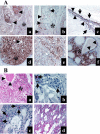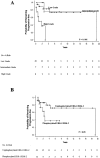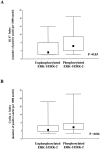Extra-cellular signal-regulated ERK-1/ERK-2 pathway activation in human salivary gland mucoepidermoid carcinoma: association to aggressive tumor behavior and tumor cell proliferation
- PMID: 12937136
- PMCID: PMC1868241
- DOI: 10.1016/S0002-9440(10)63455-4
Extra-cellular signal-regulated ERK-1/ERK-2 pathway activation in human salivary gland mucoepidermoid carcinoma: association to aggressive tumor behavior and tumor cell proliferation
Abstract
Information on oncogenetic events accompanying salivary gland mucoepidermoid carcinoma is so far limited. Activation of extracellular signal-regulated kinases ERK-1 and ERK-2 is strongly correlated to cancer. Using an antibody specific for phosphorylated (active) ERK-1/ERK-2, we examined human salivary gland mucoepidermoid carcinoma samples by immunohistochemistry. The comparison in paired tumor and normal tissue samples showed that phosphorylated ERK-1/ERK-2 immunoreactivity was higher in tumor cells as compared to surrounding normal salivary parenchyma. ERK-1/ERK-2 phosphorylation was observed in approximately 39% of mucoepidermoid carcinomas. Those tumors where the ERK-1/ERK-2 pathway was activated had a more aggressive tumor behavior as compared to the group where this pathway was inactive. The association of ERK-1/ERK-2 phosphorylation to a worse prognosis was independent of histological grade. ERK-1/ERK-2 phosphorylation was associated with increased Ki67 and cyclin A indexes, which indicated that ERK-1/ERK-2 pathway activation increased tumor cell proliferation. There was no relationship between ERK-1/ERK-2 phosphorylation and HER-2/neu or p16/INK4a protein expression. In conclusion, ERK-1/ERK-2 pathway is active in salivary gland mucoepidermoid carcinoma and this activation is associated to a more aggressive tumor behavior and a higher proliferative activity. These data suggest that deregulation of ERK-1/ERK-2 pathway contributes to mucoepidermoid carcinoma phenotype and, possibly, represents a target for new anticancer drugs.
Figures



Similar articles
-
P27, SKP2, and extra-cellular signal-related kinase signalling in human salivary gland mucoepidermoid carcinoma.Oral Oncol. 2006 Nov;42(10):1005-10. doi: 10.1016/j.oraloncology.2005.12.022. Epub 2006 Jun 6. Oral Oncol. 2006. PMID: 16757206
-
Amplification and overexpression of HER-2/neu in carcinomas of the salivary gland: correlation with poor prognosis.Cancer Res. 1994 Nov 1;54(21):5675-82. Cancer Res. 1994. PMID: 7522962
-
Immunohistochemical correlation of epidermal growth factor receptor and c-erbB-2 with histopathologic grading of mucoepidermoid carcinoma.J Cancer Res Ther. 2012 Oct-Dec;8(4):586-90. doi: 10.4103/0973-1482.106550. J Cancer Res Ther. 2012. PMID: 23361279
-
Primary Intraosseous Mucoepidermoid Carcinoma of the Maxilla.Ghana Med J. 2015 Jun;49(2):120-3. doi: 10.4314/gmj.v49i2.10. Ghana Med J. 2015. PMID: 26339097 Free PMC article. Review.
-
Proceedings of the North American Society of Head and Neck Pathology, Los Angeles, CA, March 20, 2022: Emerging Entities in Salivary Gland Tumor Pathology.Head Neck Pathol. 2022 Mar;16(1):179-189. doi: 10.1007/s12105-022-01422-z. Epub 2022 Mar 21. Head Neck Pathol. 2022. PMID: 35307772 Free PMC article. Review.
Cited by
-
Title Expression of FOXO3 and MAPK1 Genes in Patients with Benign Salivary Gland Tumors.J Clin Med. 2023 Dec 29;13(1):215. doi: 10.3390/jcm13010215. J Clin Med. 2023. PMID: 38202222 Free PMC article.
-
Cinnamaldehyde improves methamphetamine-induced spatial learning and memory deficits and restores ERK signaling in the rat prefrontal cortex.Iran J Basic Med Sci. 2018 Dec;21(12):1316-1321. doi: 10.22038/IJBMS.2018.35368.8427. Iran J Basic Med Sci. 2018. PMID: 30627377 Free PMC article.
-
Overexpression of cyclooxygenase-2 in noncancerous liver tissue increases the postoperative recurrence of hepatocellular carcinoma in patients with hepatitis B virus-related cirrhosis.Can J Gastroenterol. 2010 Jul;24(7):435-40. doi: 10.1155/2010/872570. Can J Gastroenterol. 2010. PMID: 20652159 Free PMC article.
-
Synergistic efficacy of combined EGFR and HDAC inhibitors overcomes tolerance to EGFR monotherapy in salivary mucoepidermoid carcinoma.Oral Oncol. 2021 Apr;115:105166. doi: 10.1016/j.oraloncology.2020.105166. Epub 2021 Feb 11. Oral Oncol. 2021. PMID: 33581505 Free PMC article.
-
MAPK1/3 kinase-dependent ULK1 degradation attenuates mitophagy and promotes breast cancer bone metastasis.Autophagy. 2021 Oct;17(10):3011-3029. doi: 10.1080/15548627.2020.1850609. Epub 2020 Dec 7. Autophagy. 2021. PMID: 33213267 Free PMC article.
References
-
- Ellis GL, Auclair PL: Mucoepidermoid carcinoma. Rosai J Sobin LH eds. Tumors of the Salivary Glands. 1996:pp 155-172 Armed Forces Institute of Pathology, Washington, DC
-
- Sessions R, Harrison L, Forastiere A: Tumors of the salivary glands and paragangliomas. De Vita VT Hellman S Rosenberg SA eds. Cancer: Principles and Practice of Oncology, ed 6 2000:pp 886-900 Lippicott Williams and Wilkins, Philadelphia, PA
-
- Goode RK, Auclair PL, Ellis GL: Mucoepidermoid carcinoma of the major salivary glands: clinical and histopathologic analysis of 234 cases with evaluation of grading criteria. Cancer 1998, 82:1217-1224 - PubMed
-
- Auclair PL, Goode RK, Ellis GL: Mucoepidermoid carcinoma of intraoral salivary glands: evaluation and application of grading criteria in 143 cases. Cancer 1992, 69:2021-2030 - PubMed
-
- Dardick I, Gliniecki MR, Heathcote JG, Burford-Mason A: Comparative histogenesis and morphogenesis of mucoepidermoid carcinoma and pleomorphic adenoma: an ultrastructural study. Virchows Arch A Pathol Anat Histopathol 1990, 417:405-417 - PubMed
Publication types
MeSH terms
Substances
LinkOut - more resources
Full Text Sources
Other Literature Sources
Medical
Research Materials
Miscellaneous

